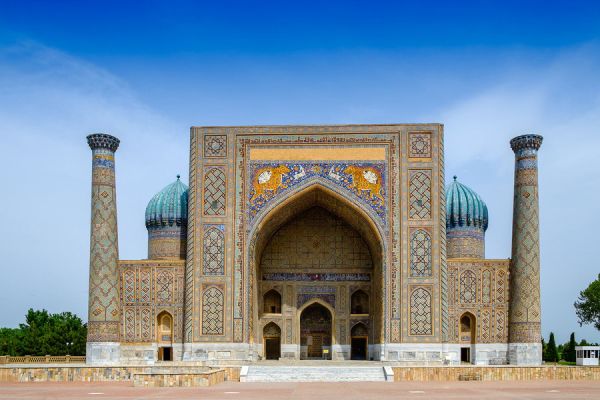Sherdor Madrasah
The Sherdor Madrasah, built in the seventeenth century, is part of the architectural complex Registan Square in Samarkand, one of the famous historical monuments of Uzbekistan.
The construction of the Sherdor Muslim educational institution was carried out by decree of the Samarkand ruler Bahadur under the supervision of the court architect Jabbar Abdullah. The decorative decoration of the building's facade was carried out under the supervision of master Muhammad Abbas.
The madrasah is built on the east side of Registan Square. To clear a place for construction, a very old khanaka (Sufi monastery) was dismantled Mirzo Ulugbek. The carefully dismantled structure of the khanaka yielded a large amount of building materials used for the construction of the Sherdor theological College, which was confirmed after archaeological excavations conducted in the sixties by the famous Soviet scientist Yurenev.
According to the architect's idea, the front facade of the madrasah building was supposed to mirror the front side of the Mirzo Ulugbek madrasah, the main parameters of which were incorporated into the basic construction of the Sherdor madrasah. But the author made a mistake by not providing in the calculations for a change in the zero level of the Registan area, which had been rising for two hundred years, reaching a two-meter mark by the time construction began. As a result, the building of the Sherdor madrasah is more squat in comparison with the Ulugbek madrasah.
Upon completion of the construction, the madrasah received the name Yalangtush Bahadur, which did not take root among the residents of Samarkand. The theological school received its current name, Sherdor, which means "having tigers" or "having lions", thanks to the mosaic panel that decorated the tympanum of the main entrance. The picturesque image depicts a hunting scene of a fabulous tiger-like animal with a lion's mane. The story depicted on the central portal of the madrasah building later became the national emblem of Uzbekistan.
During its existence, the madrasah remained a fairly significant spiritual and educational institution, despite the fact that it was inferior in status to the Mirzo Ulugbek madrasah and many educational institutions in the capital. Despite the impressive size of the building, the Sherdor Madrasah could accept no more than fifty students at a time. Among the students of the theological college were such famous personalities as the theologian Naqshbandi and the famous philosopher Shigabutdin Marjani.
Over the many years of its existence, the building of the Sherdor Theological College has withstood the blows of several devastating earthquakes that occurred in the nineteenth century. The building withstood the onslaught of the elements, having received heavy damage, the arched arch of the central entrance was deformed, the minarets were skewed, and the facing mosaics collapsed on many parts of the walls.
In the early thirties of the twentieth century, by decree of the government authorities of the Soviet state, education at the Sherdor madrasah was banned, and the building itself underwent a process of nationalization. After that, work began on the reconstruction of the madrasah, during the restoration the mosaic decoration of the tympanum of the central portal was restored, the arches of the khujra were repaired, and the decorative decoration of the facades was recreated. In the middle of the twentieth century, archaeological research was carried out within the territorial limits of the madrasah, after which the next stage of restoration work was launched. All the minarets were reconstructed and the mosaic panels decorating the tympanum located above the arch of the central entrance were recreated. The authors of the restoration project were architect Freytag and painter Gorokhov.
Built in accordance with the rules of Asian architecture of the Middle Ages, the madrasah building has the shape of a rectangle with a total area of about 4 thousand square meters. The front side of the facade is marked by a massive arched portal, the height of the central entrance is about 32 meters. The exterior corners of the building, facing the east side, are made in the form of three-quarter towers located at the level of the adjacent walls.
Surrounded by two-storey hujras, the spacious courtyard is lined with large pieces of paving stones made of slate rock. In total, forty-eight one-room residential buildings are located in Khujrah. Classrooms (darshans) are located in the four corners of the courtyard. On the front side of the building, the darshans are covered with ribbed domes shaped like spheres and decorated with turquoise-colored tiles. The auditorium, located on the right side of the central portal, was eventually converted into a tomb (gurkhana), where unidentified burials are still located. The darshan, located on the left side, with a domed roof, served as a mosque. The architecture of the side iwans, which have a multi-faceted semi-dome, is also attractive.
The artistic decoration of the madrasah building is made of a variety of materials — glazed bricks, mosaic tiles, ceramic majolica. The facades show complex patterned patterns in the form of clear geometric shapes, the visual perception of which occurs at a rather impressive distance. The domes of the minarets are decorated with convex mosaics in the style of epigraphic ornaments. The majolica ceramics used to decorate the tympanum of the main entrance are also unique. The tympanums of the arches of the living quarters are decorated with an openwork pattern created by creeping stems and exquisite flower buds. The panels made of mosaic set on the surface of the western facade's iwan are attractive — magnificent bouquets of amazing flowers standing in equally delightful vessels symbolize the tree of knowledge. The interior walls and the vault of the darkhana are painted in an ancient technique, characterized by a variety of floral, juicy patterns.























